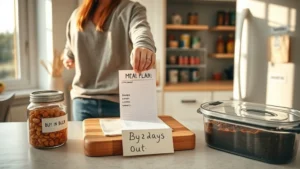Mistakes You Don’t See Coming
True story: I once bought a kitchen appliance because a YouTuber said I needed it. It churned out lumpy smoothies for about seven days, then retired to the Land of Forgotten Gadgets under my sink. Relatable? If so, welcome to my Frugal living Journal—where we air out the money goofs and the “aha!” moments, with no shame and a little bit of sass.
If you’ve ever checked your bank account only to mutter “Wait…where did it all go?”, you’re not alone. Most of us fall into finance traps—even the ones that feel subtle, like the $9-a-month subscription you forgot to cancel, or the “just this once” takeout that’s actually every Saturday. The thing is, these aren’t failures. They’re part of the learning curve, and I’m a big believer in sharing the curveball and the comebacks. Ready to trade overwhelm for a little clarity and a lot more cash in your pocket?
Why Bother With a Journal?
What Opened My Eyes?
Let’s be real: nobody wakes up excited to budget. For me, the switch flipped one afternoon when my washing machine died…and so, apparently, did my savings account. In that moment, staring at sudsy laundry in the tub, I realized my “rainy day fund” was more a drizzle-sized puddle. That’s how my Frugal living Journal began—one messy page at a time, right alongside the towel I used to soak up the spill. I started writing down every little thing I spent money on. Spoiler: it was uncomfortable at first. Like, “Do I really spend that much on coffee?” levels of uncomfortable.
Unpacking the Magpie Effect
Here’s where it got interesting—the What is frugal living mindset isn’t about perfection, it’s about awareness. Ever heard of the “magpie effect”? It’s our brain lighting up at every shiny, new, must-have thing. Science backs this up—a study on frugal behavior found we’re basically wired for FOMO and treats, making the “Wants vs. Needs” game extra tricky. Journaling helped me slow down and ask: “Is this really a need, or just something sparkly?” Spoiler: a lot of it was just glitter.
Wants vs. Needs (and Cold, Hard Savings)
| Wants (Magpie Traps) | Needs (Smart Swaps) | Monthly Savings |
|---|---|---|
| Brand-new gadgets | Repairing gear you own | $40–$80 |
| Takeout lunches | Meal-prepped leftovers | $100–$150 |
| New clothes, every season | Mix-&-match classics | $60–$120 |
Once I started seeing the upsides on paper (sometimes with a doodle or a sticky note), those “sparkly” buys didn’t feel as urgent. Not overnight, but…progress.
Money Leaks: The Tiny Drips Add Up
How My Journal Caught Them
The magic of the Frugal living Journal isn’t just the name—it’s the weird little rush you get when you spot a pattern. For example: all those “just one coffee-run” days? In a week, that was $28. That money could’ve stocked my pantry or paid for a fun mini-date. Embarrassing? Maybe. Incredibly motivating? Also yes.
There was also the monthly streaming bill. I tallied up how many nights I used it (honestly, not many), then axed it and joined the library’s “movie night in” club instead. It felt oddly freeing—like, I broke up with my old binge-watch self, and now my money could hang out with me again.
Quick Wins Without Overload
Frugality often sounds like sacrifice, but honestly, the little wins are where the fun starts. Let’s talk about my friend Jess. She’s the queen of “lazy meal-prep”—just making a double batch of pasta for dinner, tossing the leftovers in a mason jar, and calling it lunch for two more days. She saves at least $200 a month on takeout…and brags about her “gourmet” office lunches. I totally stole the idea, right after I noticed the lunch receipts piling up in my own journal.
Then there’s the Gen Z crowd—I read about a group who sees bargain-hunting as a sport, not a sacrifice. Their mantra? Durability beats deals every time. If something holds up, it wins. (Check out their habits in research on Gen Z spending.)
2025 Budget Tips To Steal
- Batch-cook and freeze meals—even if you’re not a “kitchen person.”
- Bargain-shop thrift stores for wardrobe basics, and ignore seasonal “trends.”
- Buy house staples in bulk (try to split costs with a friend—like a communal pantry!).
- Automate $5–$10 transfers to savings every payday; tiny nudges add up, promise.
- Test drive digital spending trackers—they make spending leaks way less sneaky.
Want more like this? I always peek at Frugal living tips 2025 for new hacks that don’t feel like punishment. Because if saving money is a chore…we’ll all quit by February.
Stories That Flip the Script
The Freedom In “No, Thanks”
This is my favorite lesson. We talk about saying “no” to splurges, but the freedom comes with saying “no” to the noise—the pressure to keep up, collect, or constantly upgrade. I once ditched three low-key subscriptions (music, magazines, software), and my anxiety went down almost instantly. Money aside, I finally felt like I owned my choices instead of my habits owning me. There’s a whole vibe of frugal abundance out there—where you find plenty in “enough.” This isn’t just me waxing poetic; researchers call it a pathway to satisfaction and less stress (see this journal on frugal living benefits).
Everyone’s Got a Story
If you peek at Frugal living stories, they’re filled with people who once felt “behind,” but found small ways to get ahead. I love the young couple saving for a house by cooking together and swapping home dates for restaurants—less FOMO, more inside jokes. Or the empty-nesters crafting homemade gifts instead of blowing budgets during the holidays (seriously, who doesn’t love something made with love?).
Journal Snapshots: My Before & After
| Week 1 | Week 4 |
|---|---|
| Panic at bill time Impulse buys “Where did it all go?” | Steady savings Needs-first choices Surprise: Less stress! |
This wasn’t about deprivation. I still had treats—I just understood which ones made life better (homemade pizza night!) and which were “meh” (that sad drive-thru breakfast).
Building Habits for the Long Haul (Without Hating It)
Does Frugality Equal Freedom?
Short answer: not always, but it gets you closer. In research on the frugal lifestyle and money management, they found saving more made people feel stable, less panicky—but total “freedom” is a combo of mindset and action.
Personal note: If you’ve ever been so cheap that you end up splurging later (“revenge spending” after a no-spend month…just me?), you get it. The trick is not going to extremes. I set one small, winnable goal (like, bringing lunch from home three days a week), and kept the rest lax enough that I didn’t rebel. You’ll see the difference fast. When you save intentionally, money feels like a tool, not a chain.
Let’s Make It Fun
Look, if you’re not laughing with yourself (and sometimes at yourself), the journey drags. I once hosted a “fancy” potluck where we dressed up and ate homemade casseroles—total cost per person? About $3. We made a game of rating the best thrift store finds and voted on “Most Improved Batch Cooking.” Winner got a $2 thrifted mug. It was silly and so much better than an overpriced restaurant. Turns out, fun is cheaper when you tweak what “normal” looks like.
Pro Tips and Pitfalls (from People Who’ve Been There)
- Do: Find an accountability buddy. It’s weird, but texting “Saved $6 on groceries!” is surprisingly motivating.
- Do: Celebrate tiny goals. $20 not spent = $20 closer to dreams.
- Don’t: Go extreme. If you cut every joy, you’ll burn out and binge. Balanced beats bonkers, every time.
- Don’t: Compare your journey. Your Frugal living Journal is yours, not Instagram’s.
Need a regular dose of real-talk and laughter? I find tons of these reminders in Frugal blogs 2025. Bookmark for sanity, not perfection.
Ready to Start Yours? (You Got This)
Here’s the best part: the Frugal living Journal isn’t just a notebook—it’s your new way of seeing money as a friend, not a stressor. Mine has doodles, crossed-out goals, grocery lists, and quite a few “oops” moments in the margins…but it’s honest. From big wins (paying off a credit card!) to tiny tweaks (taking the bus twice a week), every entry has moved my story forward. The secret? Don’t wait for the “perfect” time. Open a blank page—or a notes app—and jot down where your money goes today. Then, pick one habit to tweak for tomorrow. You’re not behind; you’re on your way.
Reread your first week in a month, and you’ll see: less panic, more purpose. And hey, if you slip? Welcome to the club—we all do. The win is in getting back up, adjusting, and sharing your story so others can learn, too.
So what’s your “a-ha” money moment? Start your journal, laugh at the fails, and celebrate the wins. One small frugal step each day is still a journey worth taking. Let’s do it together.













